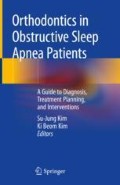Abstract
Upper airway is a soft tissue structure surrounded by oropharyngeal muscles, and the muscles is one of the genesis in OSA. As the primary treatment option in pediatric OSA or adjunctive treatment options, oropharyngeal exercises (OPE) targeting the upper airway associated muscles have been applied. OPE as a type of orofacial myofunctional therapy (MFT) is the treatment modality for OSA children and adults to train muscles related to the upper airways in order to improve nasal breathing, swallowing, sucking, chewing, and speech functions. Although limited number and heterogeneity of studies, most studies demonstrated that OPE improves the OSA severity and subjective OSA symptoms in mild-to-moderate OSA adult patients, children and adults patients with primary snoring, and children with residual apnea after surgical treatment. OPE alone or combined different treatment modalities with OPE are applied but combined treatment has proven to be more effective than either treatment used on its own.
This chapter will discuss and summarize the mechanisms of OPE, OPE effects on OSA patients, and the targeted exercises program.
Access this chapter
Tax calculation will be finalised at checkout
Purchases are for personal use only
References
de Felício CM, da Silva Dias FV, Trawitzki LVV. Obstructive sleep apnea: focus on myofunctional therapy. Nat Sci Sleep. 2018;10:271.
Hanson M. Orofacial myofunctional therapy-historical and philosophical considerations. Int J Orofacial Myology. 1988;14:3–10.
Schwartz AR, Patil SP, Laffan AM, Polotsky V, Schneider H, Smith PL. Obesity and obstructive sleep apnea: pathogenic mechanisms and therapeutic approaches. Proc Am Thorac Soc. 2008;5(2):185–92.
Malhotra A, White DP. Obstructive sleep apnoea. Lancet. 2002;360(9328):237–45.
Guimaraes K. Soft tissue changes of the oropharynx in patients with obstructive sleep apnea. J Bras Fonoaudiol. 1999;1(1):69–75.
Friedman M, Schalch P, Lin H-C, Kakodkar KA, Joseph NJ, Mazloom N. Palatal implants for the treatment of snoring and obstructive sleep apnea/hypopnea syndrome. Otolaryngol Head Neck Surg. 2008;138(2):209–16.
Saboisky JP, Butler JE, Luu BL, Gandevia SC. Neurogenic changes in the upper airway of obstructive sleep apnoea. Curr Neurol Neurosci Rep. 2015;15(4):12.
Eckert DJ, Lo YL, Saboisky JP, Jordan AS, White DP, Malhotra A. Sensorimotor function of the upper-airway muscles and respiratory sensory processing in untreated obstructive sleep apnea. J Appl Physiol. 2011;111(6):1644–53.
Ieto V, Kayamori F, Montes MI, et al. Effects of oropharyngeal exercises on snoring: a randomized trial. Chest. 2015;148(3):683–91.
Villa MP, Brasili L, Ferretti A, et al. Oropharyngeal exercises to reduce symptoms of OSA after AT. Sleep Breath. 2015;19(1):281–9.
Villa MP, Evangelisti M, Martella S, Barreto M, Del Pozzo M. Can myofunctional therapy increase tongue tone and reduce symptoms in children with sleep-disordered breathing? Sleep Breath. 2017;21(4):1025–32.
Camacho M, Certal V, Abdullatif J, et al. Myofunctional therapy to treat obstructive sleep apnea: a systematic review and meta-analysis. Sleep. 2015;38(5):669–75.
Camacho M, Guilleminault C, Wei JM, et al. Oropharyngeal and tongue exercises (myofunctional therapy) for snoring: a systematic review and meta-analysis. Eur Arch Otorhinolaryngol. 2018;275(4):849–55.
Baz H, Elshafey M, Elmorsy S, Abu-Samra M. The role of oral myofunctional therapy in managing patients with mild to moderate obstructive sleep apnea. PAN Arab J Rhinol. 2012;2(1):17–22.
Mohamed AS, Sharshar RS, Elkolaly RM, Serageldin SM. Upper airway muscle exercises outcome in patients with obstructive sleep apnea syndrome. Egypt J Chest Dis Tuberc. 2017;66(1):121–5.
Guimarães KC, Drager LF, Genta PR, Marcondes BF, Lorenzi-Filho G. Effects of oropharyngeal exercises on patients with moderate obstructive sleep apnea syndrome. Am J Respir Crit Care Med. 2009;179(10):962–6.
Diaferia G, Badke L, Santos-Silva R, Bommarito S, Tufik S, Bittencourt L. Effect of speech therapy as adjunct treatment to continuous positive airway pressure on the quality of life of patients with obstructive sleep apnea. Sleep Med. 2013;14(7):628–35.
Verma RK, Goyal M, Banumathy N, Goswami U, Panda NK. Oropharyngeal exercises in the treatment of obstructive sleep apnoea: our experience. Sleep Breath. 2016;20(4):1193–201.
Sforza E, Bacon W, Weiss T, Thibault A, Petiau C, Krieger J. Upper airway collapsibility and cephalometric variables in patients with obstructive sleep apnea. Am J Respir Crit Care Med. 2000;161(2):347–52.
Davidson TM, Sedgh J, Tran D, Stepnowsky CJ Jr. The anatomic basis for the acquisition of speech and obstructive sleep apnea: evidence from cephalometric analysis supports the great leap forward hypothesis. Sleep Med. 2005;6(6):497–505.
Arens R, Marcus CL. Pathophysiology of upper airway obstruction: a developmental perspective. Sleep. 2004;27(5):997–1019.
Hirata RP, Schorr F, Kayamori F, et al. Upper airway collapsibility assessed by negative expiratory pressure while awake is associated with upper airway anatomy. J Clin Sleep Med. 2016;12(10):1339–46.
Pearson WG, Langmore SE, Zumwalt AC. Evaluating the structural properties of suprahyoid muscles and their potential for moving the hyoid. Dysphagia. 2011;26(4):345–51.
Ertekin C, Aydogdu I. Neurophysiology of swallowing. Clin Neurophysiol. 2003;114(12):2226–44.
Miller AJ. The neurobiology of swallowing and dysphagia. Dev Disabil Res Rev. 2008;14(2):77–86.
Prikladnicki A, Martinez D, Brunetto MG, Fiori CZ, Lenz MCS, Gomes E. Diagnostic performance of cheeks appearance in sleep apnea. Cranio. 2018;36(4):214–21.
Author information
Authors and Affiliations
Corresponding author
Editor information
Editors and Affiliations
Rights and permissions
Copyright information
© 2020 Springer Nature Switzerland AG
About this chapter
Cite this chapter
Kim, KA., Kim, SJ. (2020). Oropharyngeal Exercise for OSA Patients. In: Kim, SJ., Kim, K. (eds) Orthodontics in Obstructive Sleep Apnea Patients. Springer, Cham. https://doi.org/10.1007/978-3-030-24413-2_10
Download citation
DOI: https://doi.org/10.1007/978-3-030-24413-2_10
Published:
Publisher Name: Springer, Cham
Print ISBN: 978-3-030-24412-5
Online ISBN: 978-3-030-24413-2
eBook Packages: MedicineMedicine (R0)

